On the Age of Information in a Two-User Multiple Access Setup
Abstract
:1. Introduction
Contributions
- We consider a MIMO Rayleigh fading channel in which the receiver has multiple antennas. Most of the literature assumes single-antenna setups.
- In a two-user multiple access setup, we study the performance of the average AoI of the first user for the cases of FCFS, LCFS with preemption, and queue with packet replacement when external status update packets are arriving according to a Bernoulli process. The case of FCFS can be useful when we do not allow out-of-order transmissions, since we intend to also monitor the evolution of a process in addition to the freshness. The policies of LCFS with preemption and the queue with replacement are more relevant when we do not care for the evolution of the process; thus, we can allow packet dropping.
- Furthermore, we consider a threshold for the AoI of the second user which affects the sampling and transmission frequency, and we conduct a detailed analysis for the AoI of the second user. In particular, we derive exact analytical expressions for
- The distribution of the AoI of the second user;
- The probability that the AoI of the second user is greater than a threshold;
- The average AoI of the second user;
- The average AoI of the first user for the LCFS with preemption policy by assuming the threshold for the AoI of the second user.
- We formulate and analyze a constrained optimization problem where the objective function is the average AoI of the first user for the FCFS queue discipline, with a constraint on the average AoI for the second user, which should be less than a threshold. We show that the problem is not convex in general. Then, we propose a suboptimal approach to solve the problem. Furthermore, we solve the optimization problem where the objective function is the average AoI of the first user for the LCFS scheme with preemption.
2. System Model
2.1. Physical Layer Model
2.2. The Service Probability
- When the queue of the first user is empty.
- When the queue of the first user is not empty, and it does not transmit a status update to the receiver.
- When the queue of the first user is not empty, and it transmits a status update to the receiver with probability .
3. Analysis of the Age of Information and Problem Formulation
3.1. Average Age of Information of the First User
3.2. The FCFS Geo/Geo/1 Queue
3.3. The Preemptive LCFS Geo/Geo/1 Queue
3.4. Queue with Replacement
3.5. Age of Information and the Average Age of Information of the Second User
3.6. The Average AoI of for the Preemptive LCFS Geo/Geo/1 Queue for the Threshold-Based Policy of
3.7. Optimizing the Average AoI of subject to AoI constraints on
3.7.1. Using the Average AoI of the FCFS as the objective function
3.7.2. Bilevel Convex Optimization
3.7.3. Using the Average AoI of the LCFS with Preemption as an Objective Function
4. Numerical Results and Discussion
5. Discussion on Larger Topology
6. Conclusions
Author Contributions
Funding
Institutional Review Board Statement
Informed Consent Statement
Data Availability Statement
Conflicts of Interest
Appendix A
Appendix B
References
- Kosta, A.; Pappas, N.; Angelakis, V. Age of information: A new concept, metric, and tool. Found. Trends Netw. 2017, 12, 162–259. [Google Scholar] [CrossRef] [Green Version]
- Sun, Y.; Kadota, I.; Talak, R.; Modiano, E. Age of information: A new metric for information freshness. Synth. Lect. Commun. Netw. 2019, 12, 1–224. [Google Scholar] [CrossRef]
- Kaul, S.; Gruteser, M.; Rai, V.; Kenney, J. Minimizing age of information in vehicular networks. In Proceedings of the 2011 8th Annual IEEE Communications Society Conference on Sensor, Mesh and Ad Hoc Communications and Networks, Salt Lake City, UT, USA, 27–30 June 2011; pp. 350–358. [Google Scholar]
- Kaul, S.; Yates, R.; Gruteser, M. Real-time status: How often should one update? In Proceedings of the 2012 IEEE INFOCOM, Orlando, FL, USA, 25–30 March 2012; pp. 2731–2735. [Google Scholar]
- Kaul, S.K.; Yates, R.D.; Gruteser, M. Status updates through queues. In Proceedings of the 2012 46th Annual Conference on Information Sciences and Systems (CISS), Princeton, NJ, USA, 21–23 March 2012; pp. 1–6. [Google Scholar]
- Najm, E.; Nasser, R. Age of information: The gamma awakening. In Proceedings of the 2016 IEEE International Symposium on Information Theory (ISIT), Barcelona, Spain, 10–15 July 2016; pp. 2574–2578. [Google Scholar]
- Bedewy, A.M.; Sun, Y.; Shroff, N.B. Optimizing data freshness, throughput, and delay in multi-server information-update systems. In Proceedings of the 2016 IEEE International Symposium on Information Theory (ISIT), Barcelona, Spain, 10–15 July 2016; pp. 2569–2573. [Google Scholar]
- Yates, R.D. Age of information in a network of preemptive servers. In Proceedings of the IEEE INFOCOM 2018—IEEE Conference on Computer Communications Workshops (INFOCOM WKSHPS), Honolulu, HI, USA, 15–19 April 2018; pp. 118–123. [Google Scholar]
- Najm, E.; Telatar, E. Status updates in a multi-stream M/G/1/1 preemptive queue. In Proceedings of the IEEE Infocom 2018—IEEE Conference On Computer Communications Workshops (Infocom Wkshps), Honolulu, HI, USA, 15–19 April 2018; pp. 124–129. [Google Scholar]
- Chen, Z.; Pappas, N.; Björnson, E.; Larsson, E.G. Age of information in a multiple access channel with heterogeneous traffic and an energy harvesting node. In Proceedings of the IEEE INFOCOM 2019—IEEE Conference on Computer Communications Workshops (INFOCOM WKSHPS), Paris, France, 29 April–2 May 2019; pp. 662–667. [Google Scholar]
- Pappas, N.; Kountouris, M. Delay violation probability and age of information interplay in the two-user multiple access channel. In Proceedings of the 2019 IEEE 20th International Workshop on Signal Processing Advances in Wireless Communications (SPAWC), Cannes, France, 2–5 July 2019; pp. 1–5. [Google Scholar]
- Fountoulakis, E.; Charalambous, T.; Nomikos, N.; Ephremides, A.; Pappas, N. Information Freshness and Packet Drop Rate Interplay in a Two-User Multi-Access Channel. arXiv 2020, arXiv:2006.01515. [Google Scholar]
- Kosta, A.; Pappas, N.; Ephremides, A.; Angelakis, V. Age of information performance of multiaccess strategies with packet management. J. Commun. Netw. 2019, 21, 244–255. [Google Scholar] [CrossRef]
- Zhou, B.; Saad, W. Joint status sampling and updating for minimizing age of information in the Internet of Things. IEEE Trans. Commun. 2019, 67, 7468–7482. [Google Scholar] [CrossRef] [Green Version]
- Moltafet, M.; Leinonen, M.; Codreanu, M. Worst case age of information in wireless sensor networks: A multi-access channel. IEEE Wirel. Commun. Lett. 2019, 9, 321–325. [Google Scholar] [CrossRef]
- Kadota, I.; Sinha, A.; Modiano, E. Optimizing age of information in wireless networks with throughput constraints. In Proceedings of the IEEE INFOCOM 2018—IEEE Conference on Computer Communications, Honolulu, HI, USA, 16–19 April 2018; pp. 1844–1852. [Google Scholar]
- Talak, R.; Karaman, S.; Modiano, E. Can determinacy minimize age of information? arXiv 2018, arXiv:1810.04371. [Google Scholar]
- Talak, R.; Karaman, S.; Modiano, E. Optimizing information freshness in wireless networks under general interference constraints. IEEE/ACM Trans. Netw. 2019, 28, 15–28. [Google Scholar] [CrossRef] [Green Version]
- Wu, X.; Yang, J.; Wu, J. Optimal status update for age of information minimization with an energy harvesting source. IEEE Trans. Green Commun. Netw. 2017, 2, 193–204. [Google Scholar] [CrossRef]
- Kadota, I.; Sinha, A.; Modiano, E. Scheduling algorithms for optimizing age of information in wireless networks with throughput constraints. IEEE/ACM Trans. Netw. 2019, 27, 1359–1372. [Google Scholar] [CrossRef]
- Fountoulakis, E.; Pappas, N.; Codreanu, M.; Ephremides, A. Optimal sampling cost in wireless networks with age of information constraints. In Proceedings of the IEEE INFOCOM 2020—IEEE Conference on Computer Communications Workshops (INFOCOM WKSHPS), Toronto, ON, Canada, 6–9 July 2020; pp. 918–923. [Google Scholar]
- Neely, M.J. Stochastic network optimization with application to communication and queueing systems. Synth. Lect. Commun. Netw. 2010, 3, 1–211. [Google Scholar] [CrossRef]
- Moltafet, M.; Leinonen, M.; Codreanu, M.; Pappas, N. Power minimization in wireless sensor networks with constrained AoI using stochastic optimization. In Proceedings of the 2019 53rd Asilomar Conference on Signals, Systems, and Computers, Pacific Grove, CA, USA, 3–6 November 2019; pp. 406–410. [Google Scholar]
- Chen, Z.; Pappas, N.; Björnson, E.; Larsson, E.G. Optimizing information freshness in a multiple access channel with heterogeneous devices. IEEE Open J. Commun. Soc. 2021, 2, 456–470. [Google Scholar] [CrossRef]
- Stamatakis, G.; Pappas, N.; Traganitis, A. Optimal Policies for Status Update Generation in an IoT Device with Heterogeneous Traffic. IEEE Internet Things J. 2020, 7, 5315–5328. [Google Scholar] [CrossRef]
- Chen, H.; Wang, Q.; Dong, Z.; Zhang, N. Multiuser scheduling for minimizing age of information in uplink MIMO systems. In Proceedings of the 2020 IEEE/CIC International Conference on Communications in China (ICCC), Chongqing, China, 9–11 August 2020; pp. 1162–1167. [Google Scholar]
- Zhu, Z.; Yu, B.; Cai, Y. Status Update Performance in Uplink Massive MU-MIMO Short-packet Communication Systems. In Proceedings of the 2020 International Conference on Wireless Communications and Signal Processing (WCSP), Nanjing, China, 21–23 October 2020; pp. 115–119. [Google Scholar]
- Feng, S.; Yang, J. Precoding and Scheduling for AoI Minimization in MIMO Broadcast Channels. arXiv 2020, arXiv:2009.00171. [Google Scholar]
- Tadele, B.; Shyianov, V.; Bellili, F.; Mezghani, A.; Hossain, E. Age-limited capacity of Massive MIMO. arXiv 2020, arXiv:2007.05071. [Google Scholar]
- Yu, B.; Cai, Y. Age of Information in Grant-Free Random Access with Massive MIMO. IEEE Wirel. Commun. Lett. 2021, 10, 1429–1433. [Google Scholar] [CrossRef]
- Shah, A.; Haimovich, A.M. Performance analysis of maximal ratio combining and comparison with optimum combining for mobile radio communications with cochannel interference. IEEE Trans. Veh. Technol. 2000, 49, 1454–1463. [Google Scholar] [CrossRef]
- Kosta, A.; Pappas, N.; Ephremides, A.; Angelakis, V. The Age of Information in a Discrete Time Queue: Stationary Distribution and Non-Linear Age Mean Analysis. IEEE J. Sel. Areas Commun. 2021, 39, 1352–1364. [Google Scholar] [CrossRef]
- Boyd, S.; Boyd, S.P.; Vandenberghe, L. Convex Optimization; Cambridge University Press: Cambridge, UK, 2004. [Google Scholar]
- Colson, B.; Marcotte, P.; Savard, G. An overview of bilevel optimization. Ann. Oper. Res. 2007, 153, 235–256. [Google Scholar] [CrossRef]
- Den Hertog, D. Interior Point Approach to Linear, Quadratic and Convex Programming: Algorithms and Complexity; Springer Science & Business Media: New York, NY, USA, 2012; Volume 277. [Google Scholar]
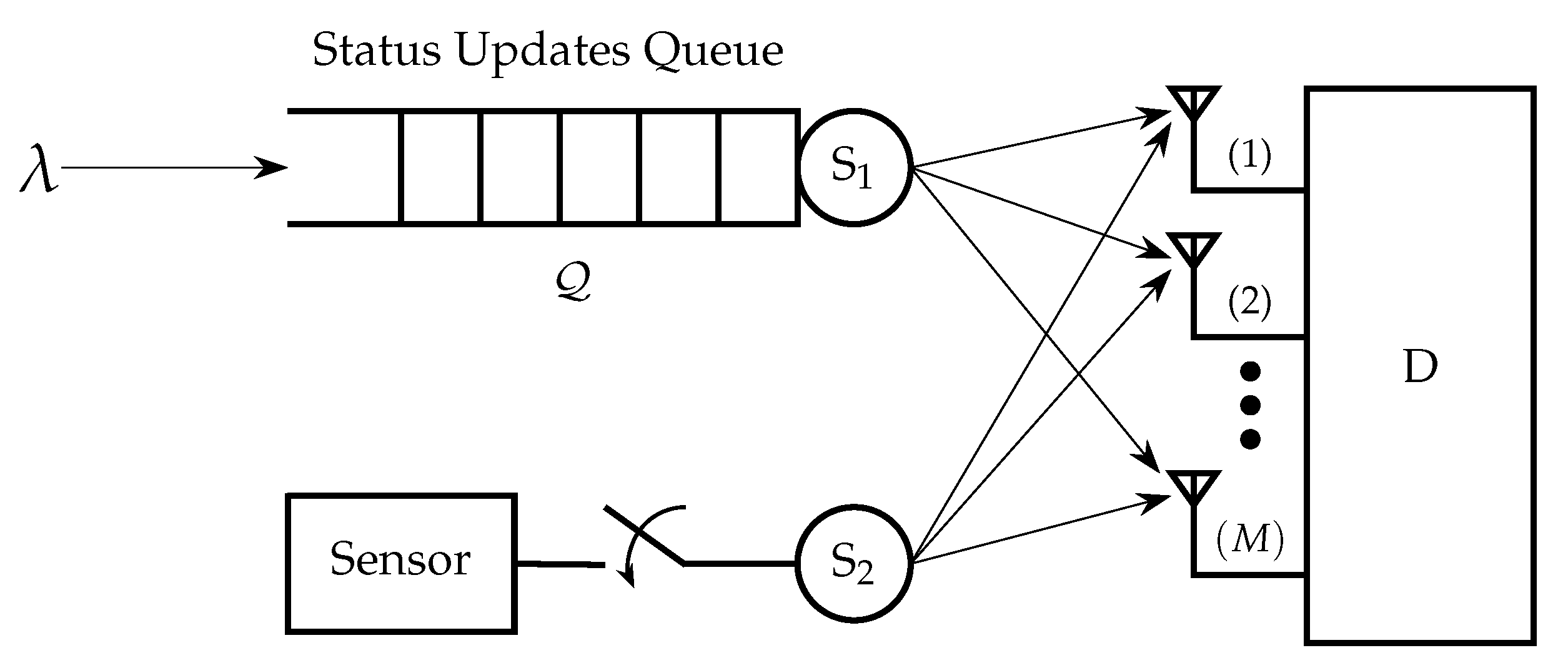
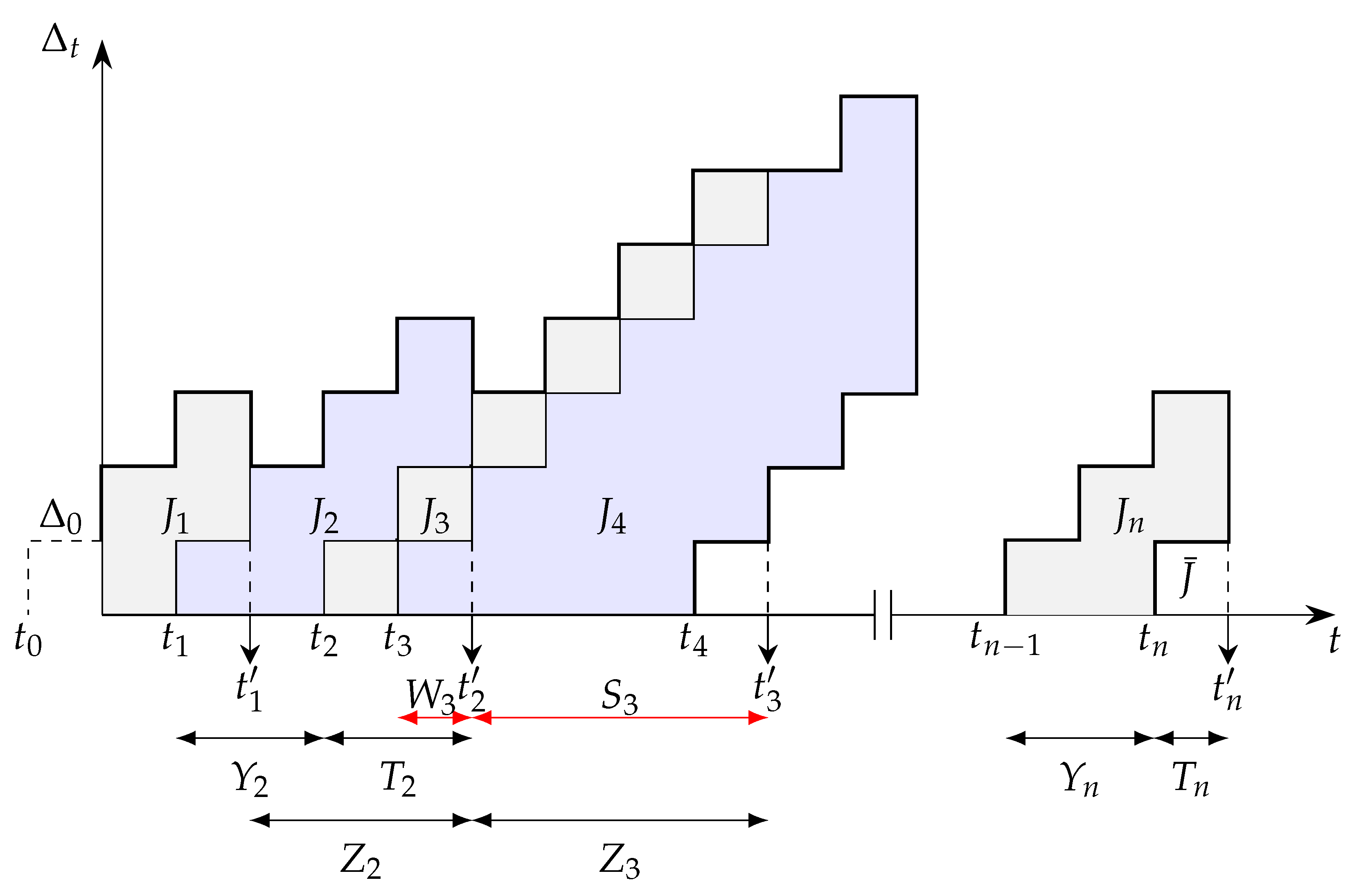

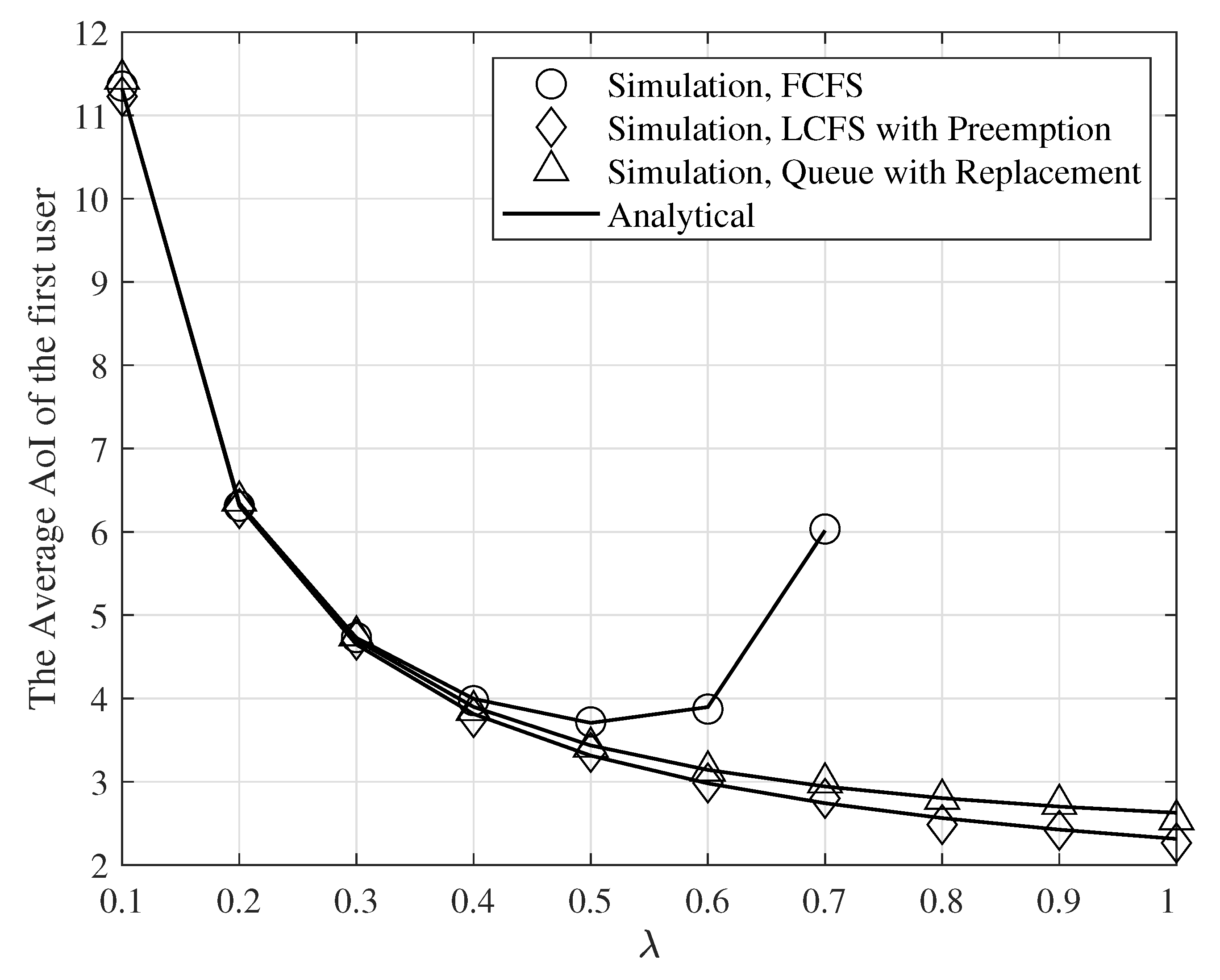
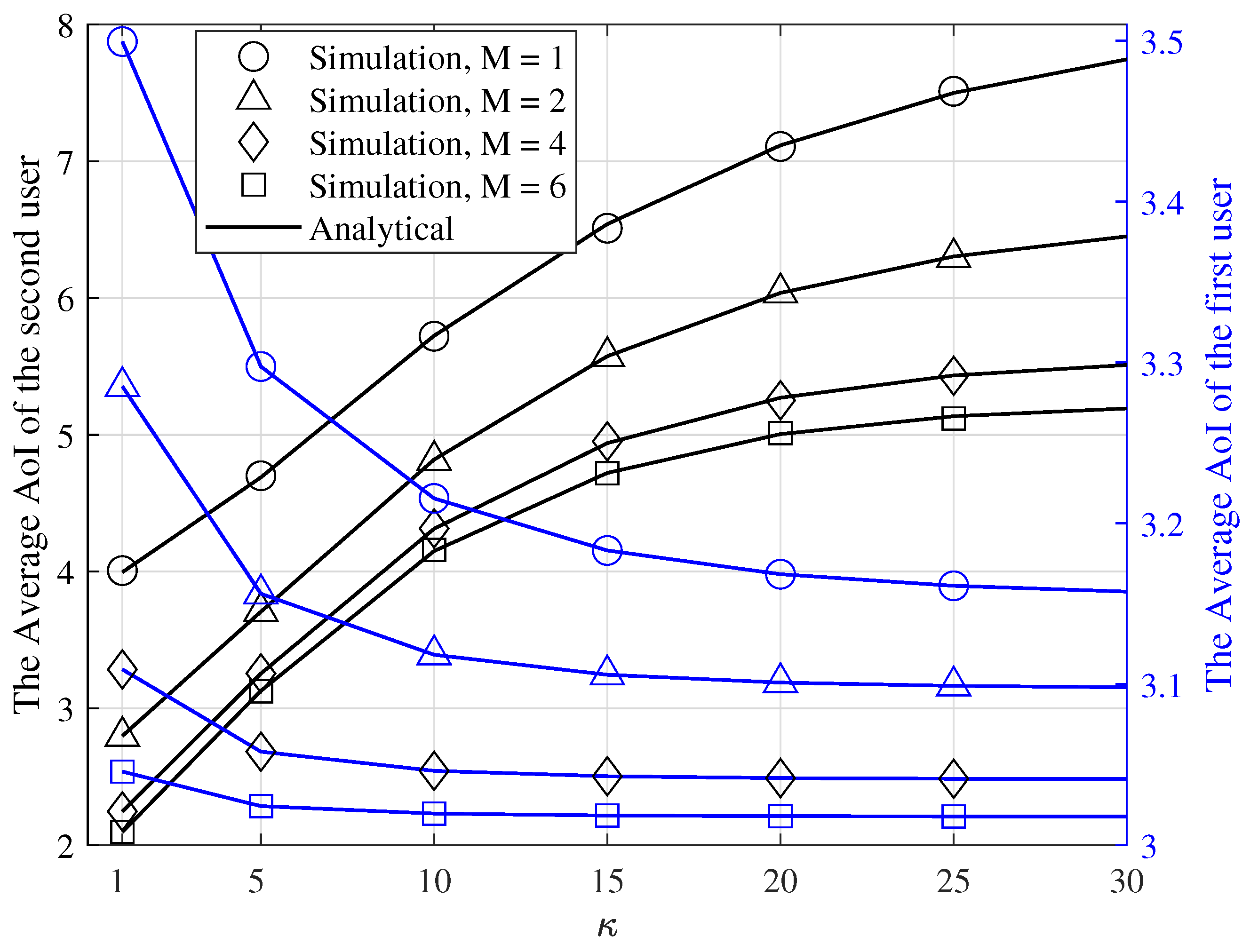
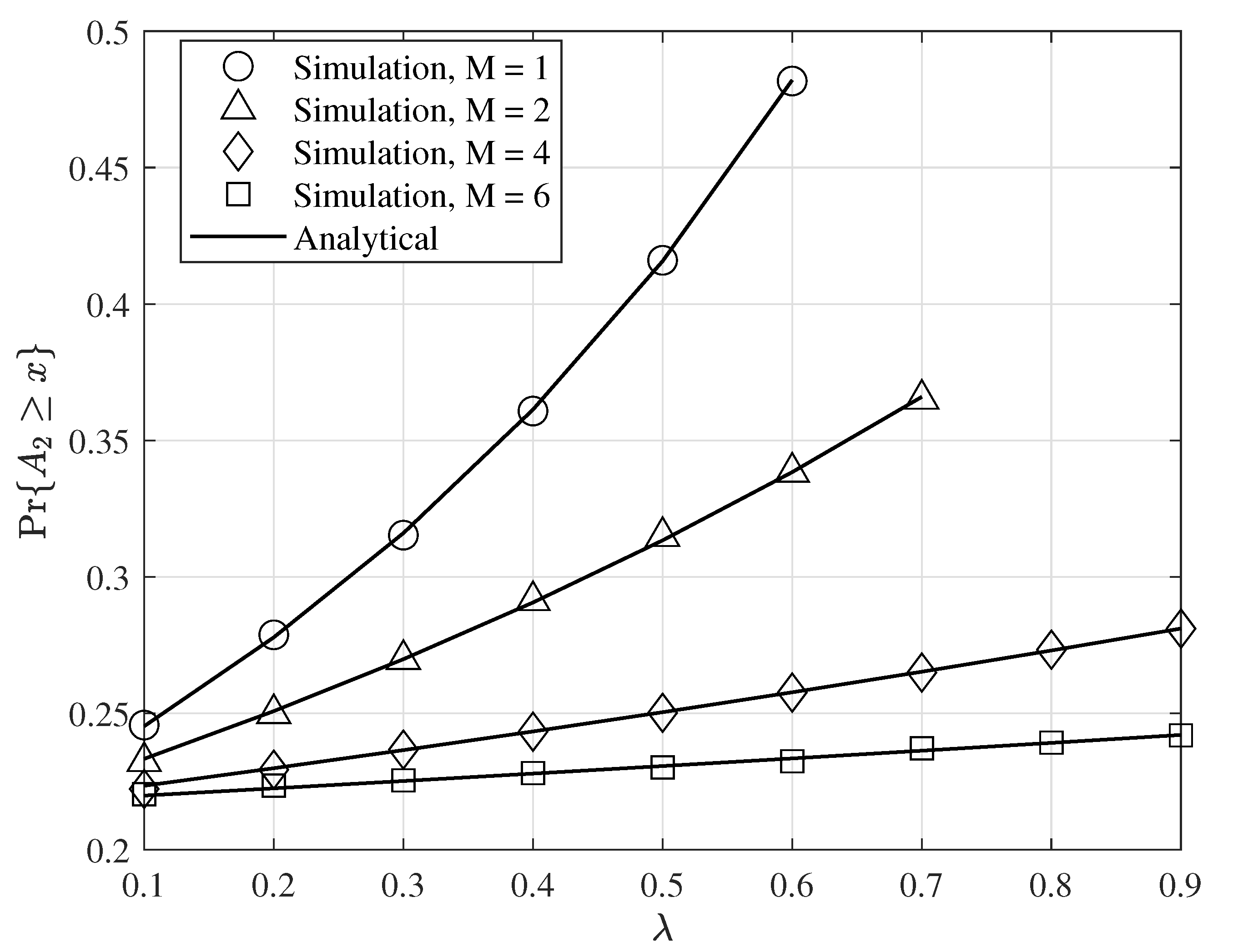
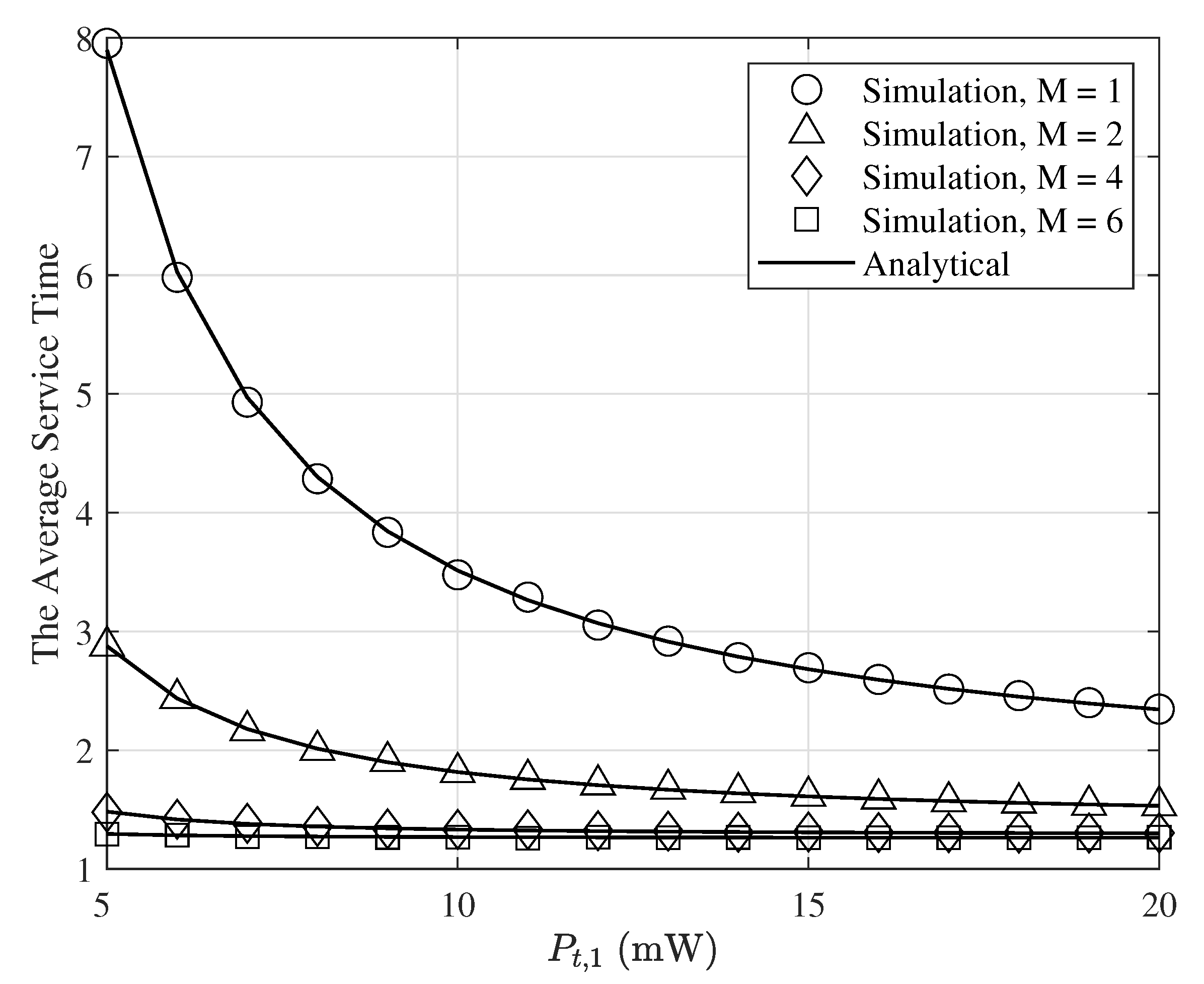
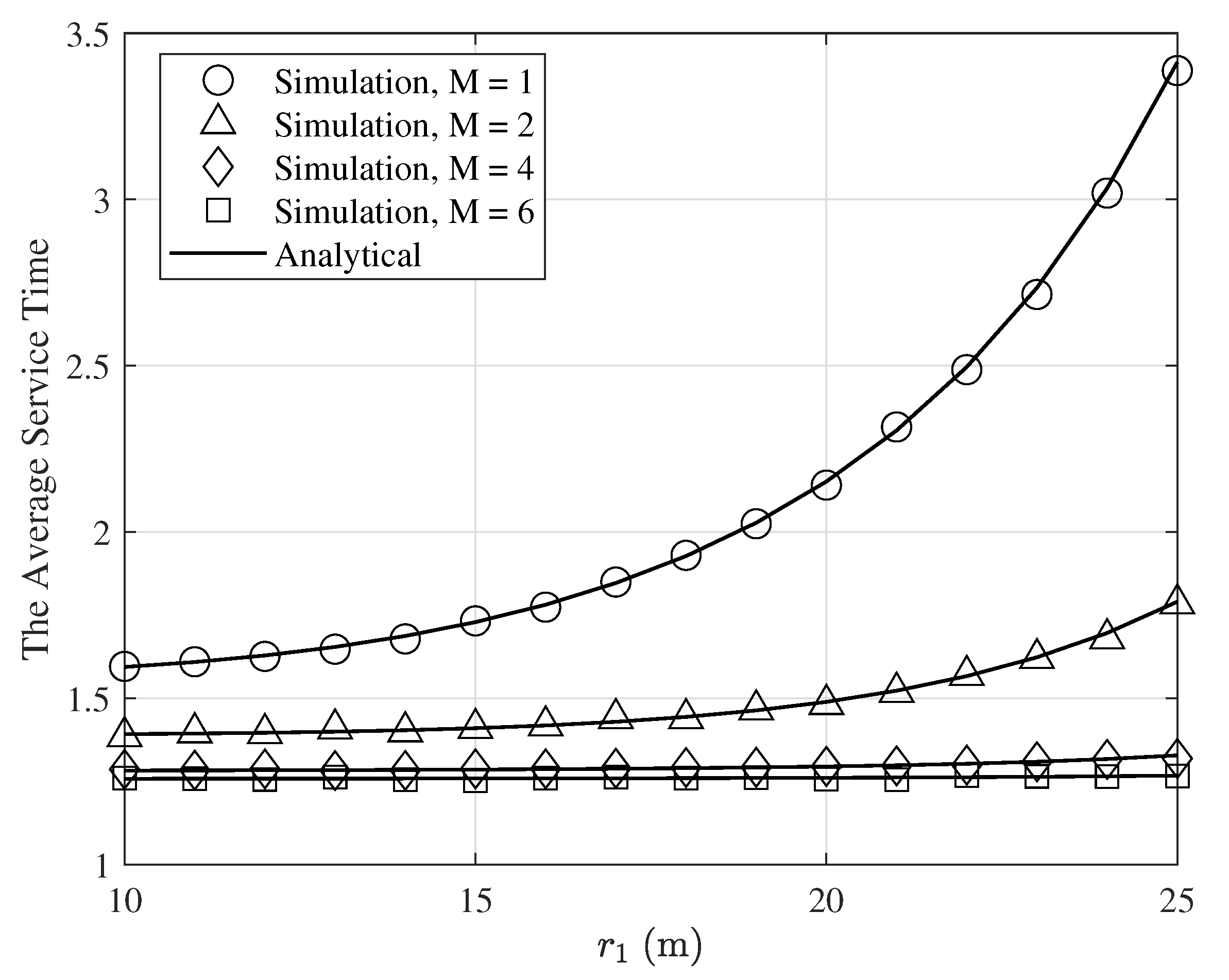
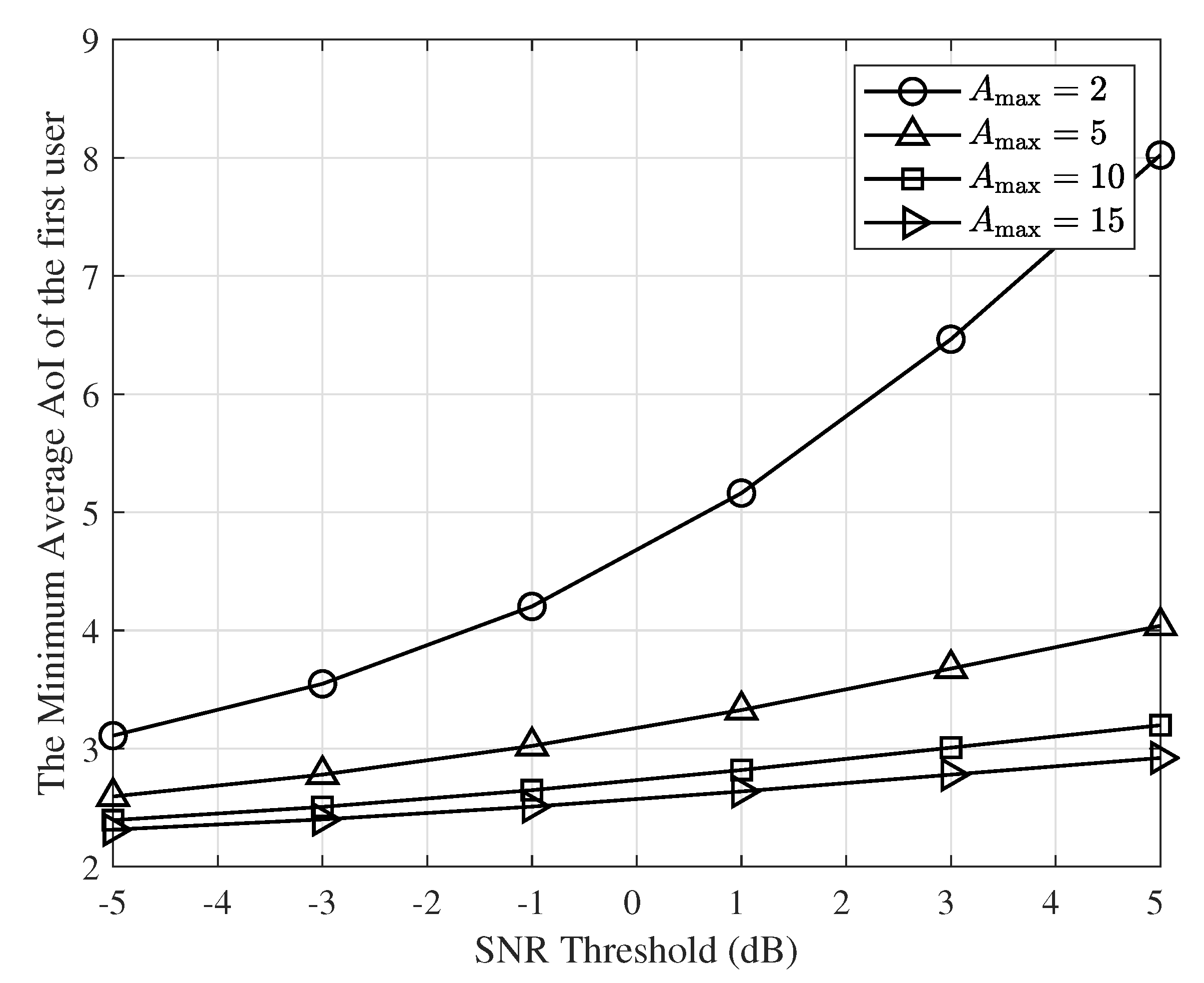
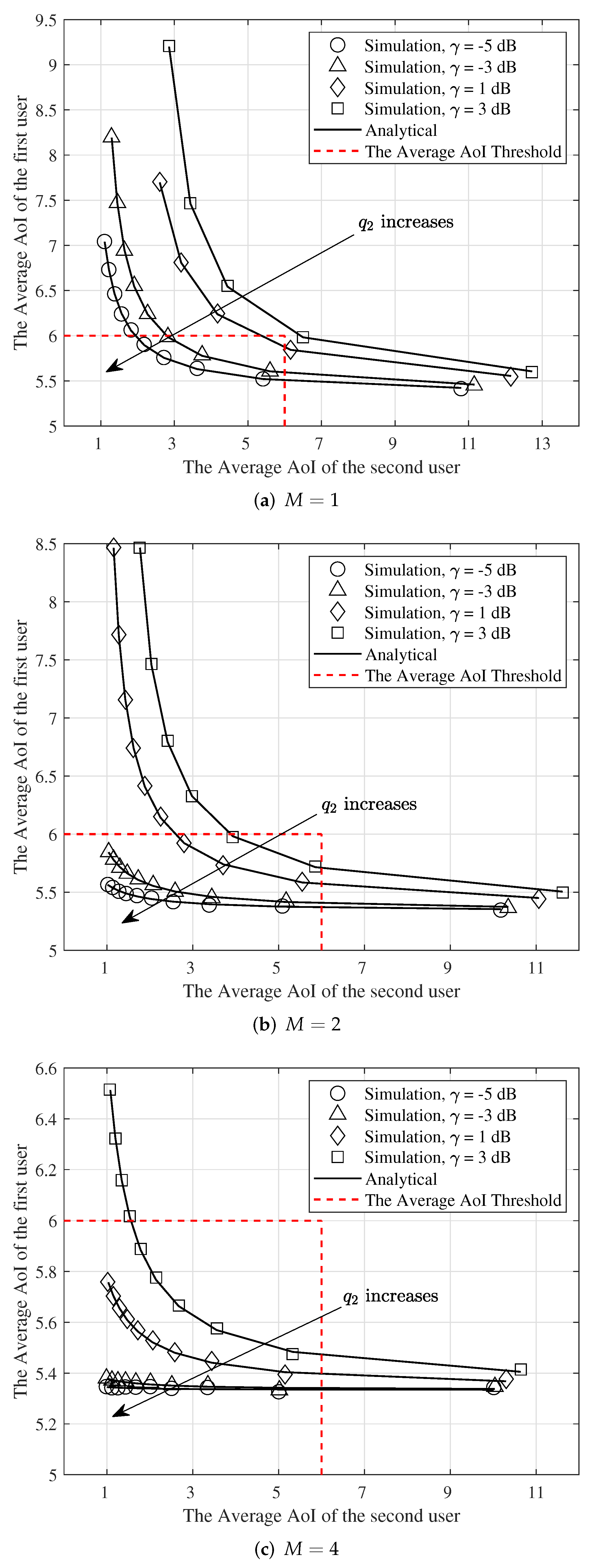
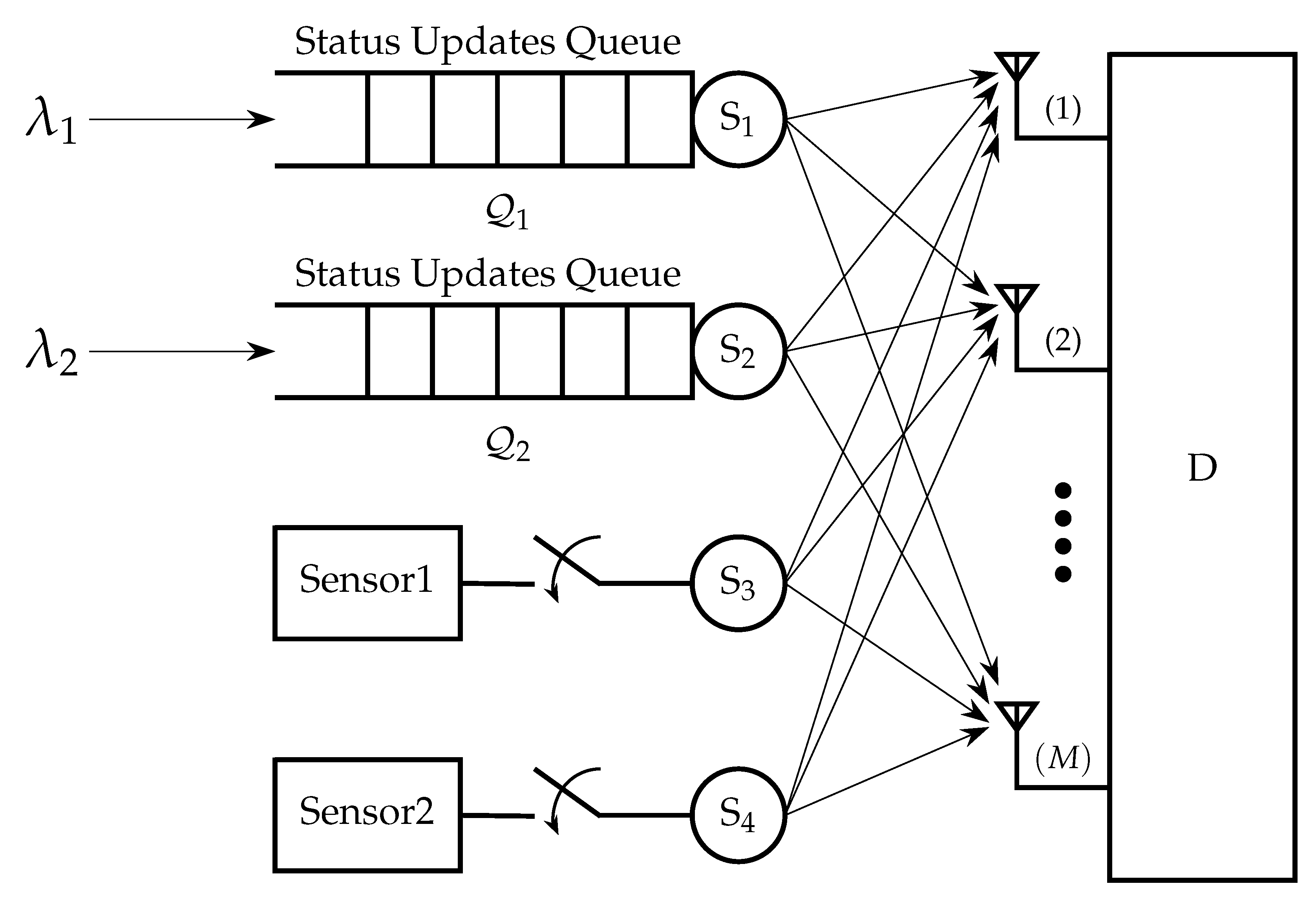
| The Minimum Average AoI of the First User | ||||
|---|---|---|---|---|
| −5 dB | 0.6159 | 1 | 0.6047 | 3.10 |
| −3 dB | 0.5264 | 1 | 0.6443 | 3.54 |
| −1 dB | 0.4263 | 1 | 0.6859 | 4.20 |
| 1 dB | 0.3264 | 1 | 0.7175 | 5.16 |
| 3 dB | 0.2425 | 1 | 0.7289 | 6.46 |
| 5 dB | 0.1832 | 1 | 0.7239 | 8.02 |
| The Minimum Average AoI of the First User | ||||
|---|---|---|---|---|
| −5 dB | 0.7539 | 1 | 0.2477 | 2.59 |
| −3 dB | 0.6947 | 1 | 0.2684 | 2.78 |
| −1 dB | 0.6260 | 1 | 0.2935 | 3.02 |
| 1 dB | 0.5519 | 1 | 0.3196 | 3.32 |
| 3 dB | 0.4806 | 1 | 0.3416 | 3.67 |
| 5 dB | 0.4208 | 1 | 0.3560 | 4.04 |
| The Minimum Average AoI of the First User | ||||
|---|---|---|---|---|
| −5 dB | 0.8246 | 1 | 0.1257 | 2.39 |
| −3 dB | 0.7815 | 1 | 0.1376 | 2.50 |
| −1 dB | 0.7303 | 1 | 0.1531 | 2.64 |
| 1 dB | 0.6730 | 1 | 0.1708 | 2.81 |
| 3 dB | 0.6147 | 1 | 0.1880 | 3.01 |
| 5 dB | 0.5622 | 1 | 0.2019 | 3.19 |
| The Minimum Average AoI of the First User | ||||
|---|---|---|---|---|
| −5 dB | 0.8563 | 1 | 0.0844 | 2.31 |
| −3 dB | 0.8206 | 1 | 0.0929 | 2.40 |
| −1 dB | 0.7777 | 1 | 0.1043 | 2.51 |
| 1 dB | 0.7288 | 1 | 0.1179 | 2.63 |
| 3 dB | 0.6775 | 1 | 0.1320 | 2.78 |
| 5 dB | 0.6297 | 1 | 0.1441 | 2.92 |
Publisher’s Note: MDPI stays neutral with regard to jurisdictional claims in published maps and institutional affiliations. |
© 2022 by the authors. Licensee MDPI, Basel, Switzerland. This article is an open access article distributed under the terms and conditions of the Creative Commons Attribution (CC BY) license (https://creativecommons.org/licenses/by/4.0/).
Share and Cite
Salimnejad, M.; Pappas, N. On the Age of Information in a Two-User Multiple Access Setup. Entropy 2022, 24, 542. https://doi.org/10.3390/e24040542
Salimnejad M, Pappas N. On the Age of Information in a Two-User Multiple Access Setup. Entropy. 2022; 24(4):542. https://doi.org/10.3390/e24040542
Chicago/Turabian StyleSalimnejad, Mehrdad, and Nikolaos Pappas. 2022. "On the Age of Information in a Two-User Multiple Access Setup" Entropy 24, no. 4: 542. https://doi.org/10.3390/e24040542
APA StyleSalimnejad, M., & Pappas, N. (2022). On the Age of Information in a Two-User Multiple Access Setup. Entropy, 24(4), 542. https://doi.org/10.3390/e24040542







